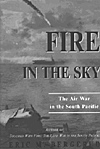
Fire in the Sky: The Air War in the South Pacific, by Eric M. Bergerud, Westview Press, 2000, 723 pp., ISBN 0-8133-2985-X, $35.00
The air battles in the South Pacific from January of 1942 to early 1944 pitted two nearly air arms against each other in a high tech war in the most primitive parts of the world. Aviation played a critical role in supporting land operations, but it is important to note that almost all land battles were fought to seize or hold air bases in this vast region. This work complements Bergerudís earlier work, Touched with Fire: the Land War in the South Pacific.
Most books on this topic focus on the aces, highly decorated air units, or specific battles. Rather than take a chronological view, Bergerud evaluates the air war from the perspective of the components of air warfare: the bases, the planes, the men, the tactics and results. This evaluation is constrained to the air war within the Port Moresby-Guadalcanal-Rabaul triangle.
The Japanese were severely hampered in their air war by having a poor industrial base. This lack played key roles in air base engineering (lack of road/airfield building machines), logistics (poor quality or missing spare parts), and training (mechanical aptitude and experience).
The vast construction projects in the Depression (Hoover Dam, Tennessee Valley Authority, highways) had developed a corps of trained and experienced civil engineers in the US who could design, build and operate complex facilities with heavy equipment, and most American troops had been exposed to automobiles, tractors and other vehicles.
Backed by a huge, untouched industrial complex, the Allies were able to more quickly build an operational air base and support facilities on a suitable piece of ground than their opponents.
Further, the Japanese lack of engineering capabilities was compounded by a lethargic build up of bases in the conquered territories, allowing the Allies to build up Port Moresby and Henderson Field before effective attacks could be mounted.
The aircraft and their weapons are examined in detail, with faults and features revealed. This includes survivability, reliability and availability of the aircraft. Examples include the low cyclic rate of the Zeroís 20mm cannon, lack of armor and self-sealing fuel tanks, which, however, contributed to the low weight and good maneuverability of the design. Also of note is the poor radios equipping Japanese aircraft, resulting in command and control problems.
The book is the size of a Tom Clancy novel, but donít be put off by the page count. It is well organized and written. Each topic is covered completely, with interviews of soldiers and airmen from both sides to emphasize Bergerudís position. It was fascinating to read and be able to comprehend the enormity of this battlefield, the complexity of the air war, and the impact of the enemies faced on a daily basis: weather, terrain, disease and an opponent bent on your destruction.
BT
Back to The Naval Sitrep #20 Table of Contents
Back to Naval Sitrep List of Issues
Back to MagWeb Master Magazine List
© Copyright 2001 by Larry Bond and Clash of Arms.
This article appears in MagWeb (Magazine Web) on the Internet World Wide Web.
Other military history articles and gaming articles are available at http://www.magweb.com